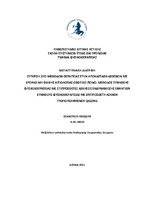| dc.contributor.advisor | Γεωργούδης, Γεώργιος | |
| dc.contributor.author | Πλαβούκου, Θεοδώρα | |
| dc.date.accessioned | 2021-10-20T07:20:35Z | |
| dc.date.available | 2021-10-20T07:20:35Z | |
| dc.date.issued | 2021-09-16 | |
| dc.identifier.uri | https://polynoe.lib.uniwa.gr/xmlui/handle/11400/1373 | |
| dc.identifier.uri | http://dx.doi.org/10.26265/polynoe-1224 | |
| dc.description.abstract | Σκοπός της παρούσας έρευνας αποτελεί η αξιολόγηση και σύγκριση της
συνήθους φυσικοθεραπευτικής φροντίδας με ένα επιπρόσθετο πρόγραμμα ασκήσεων ενδυνάμωσης,
έναντι της συνήθους φυσικοθεραπευτικής φροντίδας με επιπρόσθετη άσκηση
τροποποιημένου Qigong, σε ενήλικες ασθενείς με μη ειδικής αιτιολογίας οσφυαλγία.
Σχεδιασμός Η μελέτη αποτελεί μια διπλή τυφλή τυχαιοποιημένη κλινική δοκιμή, με την συμμετοχή
42 ατόμων (18-65) ετών που πάσχουν από χρόνια μη ειδικής αιτιολογίας οσφυαλγία.
Υλικό και μέθοδος Οι ασθενείς χωρίστηκαν σε δύο ισάριθμες ομάδες: μια ομάδα συνήθους
φυσικοθεραπείας με επιπρόσθετο πρόγραμμα ασκήσεων ενδυνάμωσης (Ν=21) και μια ομάδα
φυσικοθεραπείας με επιπρόσθετη άσκηση τροποποιημένου Qigong (Ν=21), με τυχαιοποιημένο
τρόπο. Οι ομάδες συνολικά ακολούθησαν πρόγραμμα παρέμβασης 4 εβδομάδων με 2
συνεδρίες φυσικοθεραπείας εβδομαδιαίως, διάρκεια παρέμβασης μια ώρα και συνολικό αριθμό 8
συνεδριών. Αξιολογήθηκαν τα αποτελέσματα των παρεμβάσεων και συγκρίθηκαν μεταξύ τους σε ότι
αφορά την επίδραση τους στις εξής παραμέτρους: στον πόνο, την ιδιοδεκτικότητα, την
λειτουργικότητα και την κινησιοφοβία, με εργαλεία μέτρησης
το Short form of McGill Questionnaire, το sway-length test,
το Roland Morris Disability Questionnaire (RMDQ) και τοTampa Scale of Kinesiophobia (TSK).
Αποτελέσματα. Σύμφωνα με τα αποτελέσματα και οι δύο παρεμβάσεις κρίνονται αποτελεσματικές
αφού και οι δύο παρουσιάζουν στατικά σημαντικές διαφορές μεταξύ των δυο μετρήσεων πριν και
μετά την παρέμβαση σε όλα τα μέτρα έκβασης που εξετάστηκαν. Η παρέμβαση του τροποποιημένου
Qigong αποδεικνύεται πιο αποτελεσματική στην αντιμετώπιση της κινησιοφοβίας, παρουσιάζοντας
στατιστικά σημαντική διαφορά μεταξύ των αποτελεσμάτων.
Συμπεράσματα Η άσκηση τροποποιημένου Qigong σε συνδυασμό με ένα τυπικό πρόγραμμα
φυσικοθεραπείας η οποία επιλέχθηκε, είναι πρακτικά αξιοποιήσιμη, και μάλιστα, αποδεικνύεται πιο
αποτελεσματική στην αντιμετώπιση της κινησιοφοβίας, έναντι ενός προγράμματος ενδυνάμωσης
κοιλιακών-ραχιαίων-γλουτιαίων με το αντίστοιχο τυπικό πρόγραμμα φυσικοθεραπείας σε ότι αφορά
τα βραχυπρόθεσμα αποτελέσματα αυτής τα οποία και ελέγχθηκαν στην παρούσα μελέτη | el |
| dc.format.extent | 97 | el |
| dc.language.iso | el | el |
| dc.publisher | Πανεπιστήμιο Δυτικής Αττικής | el |
| dc.rights | Αναφορά Δημιουργού - Μη Εμπορική Χρήση - Παρόμοια Διανομή 4.0 Διεθνές | * |
| dc.rights | Attribution-NonCommercial-NoDerivatives 4.0 Διεθνές | * |
| dc.rights | Attribution-NonCommercial-NoDerivatives 4.0 Διεθνές | * |
| dc.rights.uri | http://creativecommons.org/licenses/by-nc-nd/4.0/ | * |
| dc.subject | Qigong | el |
| dc.subject | Μη ειδικής αιτιολογίας οσφυαλγία | el |
| dc.subject | Χρόνια οσφυαλγία | el |
| dc.title | Σύγκριση δύο μεθόδων θεραπείας στην αποκατάσταση ασθενών με χρόνιο μη ειδικής αιτιολογίας οσφυικό πόνο: μέθοδος συνήθους φυσικοθεραπείας με επιπρόσθετες ασκήσεις ενδυνάμωσης εναντίον συνήθους φυσικοθεραπείας με επιπρόσθετη άσκηση τροποποιημένου Qigong | el |
| dc.title.alternative | Comparison of two treatment methods in rehabilitation of patients with non-specific chronic low back pain:standard physiotherapy method with additional strengthening exercises versus standard physiotherapy with additional modified Qigong exercises | el |
| dc.type | Μεταπτυχιακή διπλωματική εργασία | el |
| dc.contributor.committee | STASINOPOULOS, DIMITRIOS | |
| dc.contributor.committee | Papathanasiou, George | |
| dc.contributor.faculty | Σχολή Επιστημών Υγείας & Πρόνοιας | el |
| dc.contributor.department | Τμήμα Φυσικοθεραπείας | el |
| dc.contributor.master | Νέες Μέθοδοι στη Φυσικοθεραπεία | el |
| dc.description.abstracttranslated | Objectives: the aim of this study was to evaluate and compare the efficacy of standard physiotherapy
protocol with additional strengthening exercises versus standard physiotherapy protocol with
additional modified Qigong exercises, among adults who suffered from non-specific low back pain.
Design The study was designed as a double blind randomized controlled trial, involving 42 people aged
18-65 with chronic non-specific low back pain.
Material-method The study had two experimental groups: a group of standard physiotherapy with
additional strengthening exercises (Ν=21) and a group of standard physiotherapy with additional
modified Qigong exercises (Ν=21). The intervention program lasted for 4 weeks. The duration of the
intervention was one hour per treatment session and the frequency of the sessions was twice a week
for a total sessions of 8 sessions. The result of the interventions were evaluated and compared with
each other in terms of the their effectiveness on the following parameters: pain, proprioception,
disability and kinesiophobia, with respective measuring tools the short form of McGill Questionnaire,
the sway length test, the Roland Morris Disability Questionnaire and the Tampa scale of Kinesiophobia.
Results. According to the results both treatment groups are considered effective, since both show
statically significant differences between the two measurements before and after the intervention in
all the outcome measures examined. However, the intervention of the modified Qigong proves to be
more effective in treating kinesiophobia, showing a statistically significant difference between the
results after the intervention in the two groups. Participants in routine physiotherapy intervention
with additional modified Qigong exercise had a greater change (reduction) in kinesiophobia score than
participants in the routine physiotherapy group with an additional program of strengthening exercises.
Conclusion The practice of modified Qigong in combination with a standard physiotherapy program
that has been chosen, is practically useful, and in fact, proves to be more effective in treating especially
kinesiophobia against an abdominal-back-glutei strengthening program with the corresponding
standard physiotherapy program, in terms of its short-term results which were tested in the present
study. | el |


